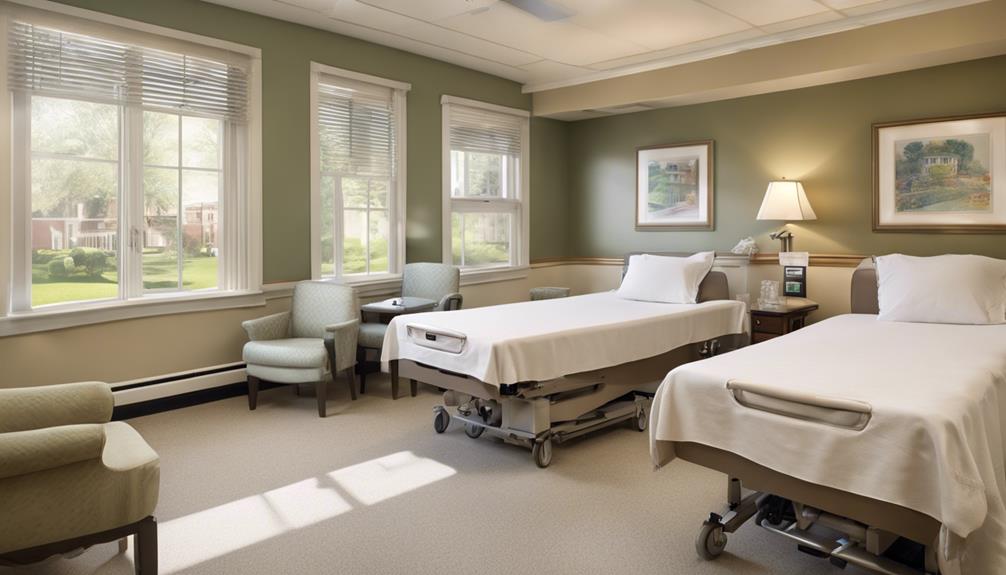When comparing the costs associated with nursing homes to those of assisted living facilities, the data clearly illustrates the existing financial differences.
As we delve into the intricate details of these costs, one can't help but wonder about the implications for long-term care planning and the potential impact on individuals and their families.
The comparative analysis not only sheds light on the monetary aspects but also prompts us to consider the broader implications of these financial decisions in the realm of elderly care.
Key Takeaways
- Nursing homes cost more at $7,441 monthly compared to assisted living at $4,000.
- Assisted living offers flexibility and personal care, while nursing homes focus on medical services.
- Additional service charges vary based on care needs, impacting total expenses.
- Understanding costs and care differences is crucial for informed decision-making.
Overview of Care Facilities
When entering the realm of care facilities, it's crucial to understand the distinct services provided by nursing homes and assisted living facilities. Nursing homes offer 24-hour medical care and support, catering to seniors with serious health issues who require constant attention.
On the other hand, assisted living facilities provide personal care and social support in a more home-like environment, fostering independence while ensuring assistance is readily available. Many assisted living communities also have specialized Alzheimer's care units to meet the unique needs of residents with memory issues.
The cost comparison between nursing homes and assisted living is significant, with nursing homes averaging around $7,441 per month, while assisted living costs approximately $4,000 per month, making it a more affordable option for many individuals. Understanding these differences in services and costs is essential for families seeking the best care option for their loved ones.
Whether it's 24-hour care for seniors with complex medical needs or a supportive environment for those seeking personal care and support, both nursing homes and assisted living facilities play crucial roles in senior care.
Accommodation and Meal Costs

In comparing the accommodation and meal costs between assisted living facilities and nursing homes, it's evident that there's a notable difference in pricing structures. Assisted living communities typically charge around $4,000 per month for accommodation, whereas nursing homes can cost approximately $7,441 monthly.
Meal costs are usually included in the overall monthly fee for both types of facilities. However, residents in assisted living may enjoy more flexibility with meal options and dining schedules compared to those in nursing homes.
The significant cost difference between the two reflects the varying levels of care and services provided in each setting. In assisted living, residents often have private apartment-style units, while nursing homes may offer shared living quarters based on individual needs.
Understanding these distinctions can help families make informed decisions based on their loved ones' preferences and needs. It's crucial to consider not just the expenses but also the quality of life and care that each option offers.
Medical Care Expenses
Medical care expenses in nursing homes are typically higher than those in assisted living facilities due to the specialized and intensive services provided. In nursing homes, the average cost of $7,441 per month reflects the need for extensive medical care and supervision, whereas assisted living facilities, with costs around $4,000 per month, focus more on personal care and activities of daily living.
| Category | Nursing Homes | Assisted Living Facilities |
|---|---|---|
| Monthly Cost | $7,441 | $4,000 |
| Medical Care | Higher | Lower |
| Services Provided | Extensive | Personal Care |
The cost comparison between these two options is crucial for individuals seeking appropriate care. While nursing homes offer specialized medical services, assisted living facilities cater more to personal needs. Understanding the differences in medical care expenses can help individuals make informed decisions based on their requirements and financial capabilities.
Additional Service Charges

Given the varying levels of care and services provided in nursing homes and assisted living facilities, understanding the additional service charges associated with each is essential for making informed decisions about long-term care options.
In assisted living facilities, additional service charges may encompass fees for specialized care, like memory care tailored for Alzheimer's patients. Moreover, assisted living facilities may add extra costs for services such as transportation, personal grooming assistance, and medication management.
On the other hand, nursing homes typically incur higher additional service charges due to the provision of intensive medical care and constant monitoring. Nursing homes may charge for therapy sessions, medical equipment usage, and specialized nursing care.
The pricing of additional services in both settings can fluctuate based on the resident's required level of care. Therefore, when considering long-term care options, it's crucial to carefully assess the additional service charges to ensure that the chosen facility aligns with the individual's needs and budget.
Comparison of Total Cost
Upon comparing the total cost of care between nursing homes and assisted living facilities, the financial disparity becomes evident, with nursing homes averaging approximately $7,441 per month compared to the average of $4,000 for assisted living. According to the Cost of Care Survey, assisted living costs typically range from $4,800 to $5,200 per month for supervised Alzheimer's care.
The higher cost of nursing home care is primarily due to the increased level of medical attention provided. While Medicaid coverage can assist with nursing home expenses, individuals usually need to deplete their assets before qualifying for support. However, financial assistance options are available for both assisted living and nursing homes, including specialized programs for Alzheimer's care.
Understanding the levels of care and associated costs is crucial for families making decisions about long-term care. By being informed about the average monthly costs and available financial assistance, individuals can navigate the complexities of choosing the most suitable option for their loved ones' well-being.
Frequently Asked Questions
How Does Assisted Living Differ From Nursing Home?
Assisted living and nursing homes differ in the level of care provided. Assisted living offers support for seniors who can maintain some independence, living in private apartments with help for daily tasks.
On the other hand, nursing homes provide higher medical care, often for those with serious health issues, in shared living quarters with round-the-clock supervision.
This distinction in care levels impacts the overall experience and costs associated with each option.
How Much Do Most Nursing Homes Cost a Month?
We've found that the current average monthly cost for a nursing home is around $7,441. Keep in mind that this figure can fluctuate based on various factors like location, amenities, and the level of care needed.
While this may seem daunting, there are ways to help cover these expenses, such as Medicaid for eligible individuals or long-term care insurance.
It's important to explore all options and plan ahead for potential long-term care needs.
What Are the Disadvantages of Assisted Living?
When considering the disadvantages of assisted living, it's crucial to acknowledge the limited medical care available compared to nursing homes. Individuals needing 24/7 medical supervision or specialized care for complex health conditions may find assisted living inadequate. This could lead to residents needing to transition to nursing homes for higher medical needs.
Additionally, the cost of assisted living is often higher than living at home with in-home care services, making it a financial consideration as well.
What Is the Highest Level of Assisted Living?
At the highest level of assisted living, specialized memory care units cater to individuals with Alzheimer's or dementia. These units offer increased supervision and personalized care for those with cognitive impairments, providing support with daily activities and personal care.
Residents benefit from a structured environment and tailored programming to address their complex needs. This level of care ensures individuals with advanced cognitive decline can maintain quality of life and receive the necessary support.
Conclusion
As we navigate the complex world of long-term care, the contrasting costs of nursing homes and assisted living facilities serve as a symbol of the sacrifices we make for our loved ones.
The financial burden can weigh heavy on our hearts, but with careful planning and informed decisions, we can provide the care and support our family members deserve.
Let's embrace the challenges ahead with empathy, knowledge, and a clear understanding of the costs involved.









